- Business Concepts ›
- Operations and Supply Chain ›
- Distribution Metrics
Distribution Metrics
Definition, Importance & Example
This article covers meaning & overview of Distribution Metrics from operations perspective.
What is meant by Distribution Metrics?
Distribution metrics are the performance indicators that help the people concerned to obtain maximum volume that passes through the sales and distribution network. Marketing managers have distribution metrics at their disposal when they want to reveal the percentage of market their brand has encapsulated. Distribution metrics are very much helpful in determining the trade-off that brand managers need to carry out between push and pull.
The distribution coverage is actually seen through these distribution metrics and the metrics are namely:
1. Numeric Distribution
2. All commodity volume (ACV)
3. Product Category Volume (PCV)
4. Category Performance Ratio (CPR)
Importance of Distribution Metrics
Distribution is the medium in the sales and distribution network and the metrics determining the distribution scenario are of much importance when the brand managers are looking for solving some problems in the supply chain or when they are exploring points in the network where they can optimize those metrics to a level that is in level with competitors. Major part of any distribution and sales network is Supplier Relationship Management, which is not under the purview of Distribution metrics.

Marketers through the years have used distribution metrics to judge the effectiveness of the distribution systems and these have indeed helped them create opportunities to buy. In a simplistic manner, the numeric distribution is the proportion of stores/ outlets in the market that are carrying your brand. All commodity volume on the other hand helps the marketers know the product availability or distribution, based on the total sales that can be known in percentages or in dollar values too. Product category volume is an improvement over numeric distribution and all commodity volume as it only sees the category sales made by stores that have stocked at least one stock keeping unit (SKU) of the brand in view when compared to all stores in the universe.
Read More
Formula & Workings of Distribution Metrics
Some of the important distribution metrics are mentioned as follows:
Numeric Distribution (%) = (Total number of products carrying product (#))/(Total number of outlets in the market (#))
Total Distribution=∑ (ACV or PCV of all the brands SKUs calculated individually)
All Commodity Volume (ACV Distribution)(%)=(Total sales of stores carrying brand ($))/(Total sales of all stores ($))
All Commodity Volume (ACV Distribution)($)=Total sales of stores carrying Brand ($)
Product Category Volume (PCV Distribution)(%)=(Total category sales by stores carrying brand ($))/(Total category sales of all stores ($))
Product Category Volume (PCV Distribution)($)=Totalcategory sales of stores carrying brand ($)
Another metric that is helpful for distribution measures is Category Performance Ratio (CPR)
CPR (%)=(PCV (%))/(ACV (%))
It tells whether the brands distribution network is effective or not for selling the category that the brand belongs to.
Example of Distribution Metrics
Sarah sells photo reels to studios. There are 60 such stores in his city and in order to generate adequate coverage, Sarah believes he must reach at least 60% of these studios. For starting a relationship, Sarah must provide the store $4000 worth of inventory to build presence. How much does Sarah need to invest?
Answer:
Sarah must reach at least 60% of 60 studios i.e. 36 studios. Then he will have to spend $4000 on each of them, giving a sum of $144,000.
Hence, this concludes the definition of Distribution Metrics along with its overview.
This article has been researched & authored by the Business Concepts Team which comprises of MBA students, management professionals, and industry experts. It has been reviewed & published by the MBA Skool Team. The content on MBA Skool has been created for educational & academic purpose only.
Browse the definition and meaning of more similar terms. The Management Dictionary covers over 1800 business concepts from 5 categories.
Continue Reading:
What is MBA Skool?About Us
MBA Skool is a Knowledge Resource for Management Students, Aspirants & Professionals.
Business Courses
Quizzes & Skills
Quizzes test your expertise in business and Skill tests evaluate your management traits
Related Content
All Business Sections
Write for Us